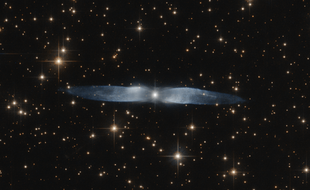Hen 2-437
| Planetarischer Nebel Hen 2-437 | |
|---|---|
 | |
| Aufnahme des Hubble-Weltraumteleskops | |
| AladinLite | |
| Sternbild | Fuchs |
| Position Äquinoktium: J2000.0 | |
| Rektaszension | 19h 32m 57,657s [1] |
| Deklination | +26° 52′ 43,35″[1] |
| Erscheinungsbild | |
| Zentralstern | |
| Physikalische Daten | |
| Geschichte | |
| Entdeckung | Rudolph Minkowski |
| Datum der Entdeckung | 1946 |
| Katalogbezeichnungen | |
| PK 061+03 1 • Hen 2-437 IRAS 19309+2646 PN ARO 154 PN G061.3+03.6 PN M 1-91 Min 1-91 PN M 4-15 | |
Hen 2-437, auch M 1-91, ist ein planetarischer Nebel im Sternbild Fuchs. Über die Entdeckung des Nebels berichtete Rudolph Minkowski im Jahr 1946, wobei er auf die symmetrische, schmale Gestalt hinwies.[2] Die Beobachtung wurde von Karl Gordon Henize 1967 bestätigt und in seinem Katalog planetarischer Nebel aufgenommen.[3]
Weblinks
- astronews.com: Bild des Tages 12. Februar 2016
- The icy blue wings of Hen 2-43 (engl.)
Einzelnachweise
- ↑ Simbad Hen 2-437
- ↑ Rudolph Minkowski: New Emission Nebulae, bibcode:1946PASP...58..305M
- ↑ Karl Gordon Henize: Observations of Southern Planetary Nebulae, bibcode:1967ApJS...14..125H
Auf dieser Seite verwendete Medien
Autor/Urheber: Judy Schmidt, Lizenz: CC BY 2.0
An infrared, pseudogreen, red light view of a beautifully symmetrical bipolar preplanetary nebula (are we just calling these 'young' planetary nebulas now?). The blue appearance is due to the filters used. Note the blue outflows are glowing, ionized gas, not dust. There is a very faint but curious stray bit of gas pointing directly back to the central star down and to the left of the nebula.
Thumbnails in the HLA are of awful quality and obviously created with some error but the actual data (acquired through DADS) is very nice looking.
This object was also imaged for <a href="http://archive.stsci.edu/proposal_search.php?mission=hst&id=10536" rel="nofollow">proposal 10536</a>.
Red: ACS/WFC F814W Green: Pseudo Blue: ACS/WFC F606W
North is NOT up. It is 9.77° counter-clockwise from up.